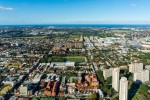Eco-Friendly Practices for the Rainy Season
The rainy season in the Philippines, typically from June to November, brings cooler temperatures, lush greenery, and, unfortunately, occasional floods and power interruptions. While it can be challenging, it's also a season full of opportunities—especially for those who want to start living more sustainably.
In this blog, we’ll explore simple yet impactful eco-friendly habits you can adopt this rainy season. Whether you're at home, in school, or running a business, these small changes can help the environment and even save you money.
1. Start a Rainwater Harvesting System
With heavy rainfall almost daily, why not collect some of that water? You can use collected rainwater for:
Watering plants
Flushing toilets
Cleaning outdoor areas
Tip: Use food-grade barrels or large clean containers with a screen on top to keep out debris and mosquitoes. This is especially useful in areas where water supply becomes limited during typhoons or service interruptions.
2. Switch to Solar-Powered Emergency Tools
Brownouts are common during typhoons. Instead of relying on battery-powered flashlights or gasoline generators, invest in solar-powered lights, chargers, and radios. They charge during the day and keep you connected and safe at night—without emissions.
Bonus: Solar-powered gadgets are now widely available and affordable in the Philippines.
3. Use Reusable Rain Gear
Instead of buying single-use plastic raincoats or cheap umbrellas that break after a few uses, invest in:
A high-quality, reusable umbrella
A durable raincoat
Waterproof boots or sandals made from sustainable materials
It may cost more upfront, but these items last longer and reduce waste in the long run.
4. Ditch Plastic—Even When It’s Wet
During the rainy season, we’re often tempted to use plastic bags or coverings to "protect" things from getting wet. Instead, consider:
Waterproof reusable bags for your groceries or errands
Fabric tote bags lined with water-resistant material
Silicone food covers instead of cling wrap
Pro tip: Keep a foldable waterproof bag in your everyday bag so you're always prepared!
5. Eat Seasonal and Local Produce
Rainy season means certain fruits and vegetables are in abundance, such as:
Kamote (sweet potato)
Sayote (chayote)
Kalabasa (squash)
Langka (jackfruit)
Bananas
Buying local and in-season not only reduces the carbon footprint from transportation but also supports Filipino farmers.
6. Compost Your Kitchen Waste
With more time spent indoors, you’re likely cooking more meals at home. Use this opportunity to compost:
Fruit and vegetable peels
Coffee grounds
Eggshells
Leftover rice
Rainy weather makes compost bins naturally moist—perfect for breaking down organic material faster.
Don’t forget: Keep composting bins covered to prevent odors and pests.
7. Repair Instead of Replace
Rain and moisture often damage household items, clothes, or shoes. Instead of throwing them out, try:
Waterproofing your items ahead of time with eco-friendly sprays
Sewing up tears in bags or jackets
Fixing broken zippers or soles
You extend the life of your belongings and reduce landfill waste.
8. Support Eco-Conscious Businesses
Rainy days are great for online shopping or food delivery. When you do:
Choose local sellers that use minimal or compostable packaging
Support restaurants offering plastic-free delivery
Leave a note asking for no extra utensils or straws
Your small actions send a big message to businesses to become more sustainable.
9. Create a Home Garden (Rain Edition)
The rainy season is perfect for growing leafy greens and herbs like:
Pechay
Kangkong
Basil
Talbos ng kamote
Use recycled containers like plastic bottles, old buckets, or even broken pots. Just make sure drainage holes are in place to prevent root rot.
Eco-benefit: Plants help absorb excess rainwater and reduce flooding around your home!
10. Educate Your Family and Barangay
True change starts with awareness. Use rainy days as a chance to:
Teach kids how to sort waste properly
Share tips on saving electricity and water
Organize or join barangay-level clean-ups once the weather clears
Rainy season is also typhoon season—having an environmentally aware community can make recovery easier and quicker for everyone.
Final Thoughts
Living eco-friendly isn’t about perfection—it’s about making mindful choices daily. The rainy season in the Philippines presents both challenges and opportunities. By adopting these green habits, you're not only protecting the environment—you’re helping build a more resilient and sustainable future for all.




